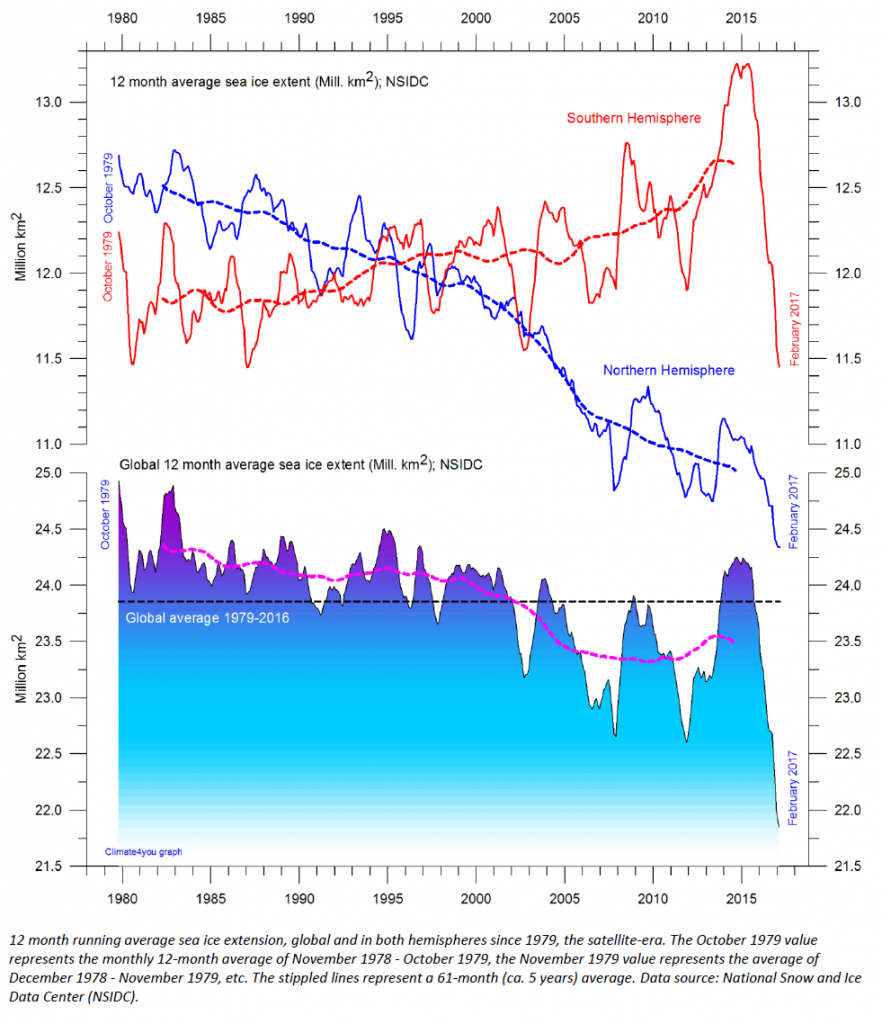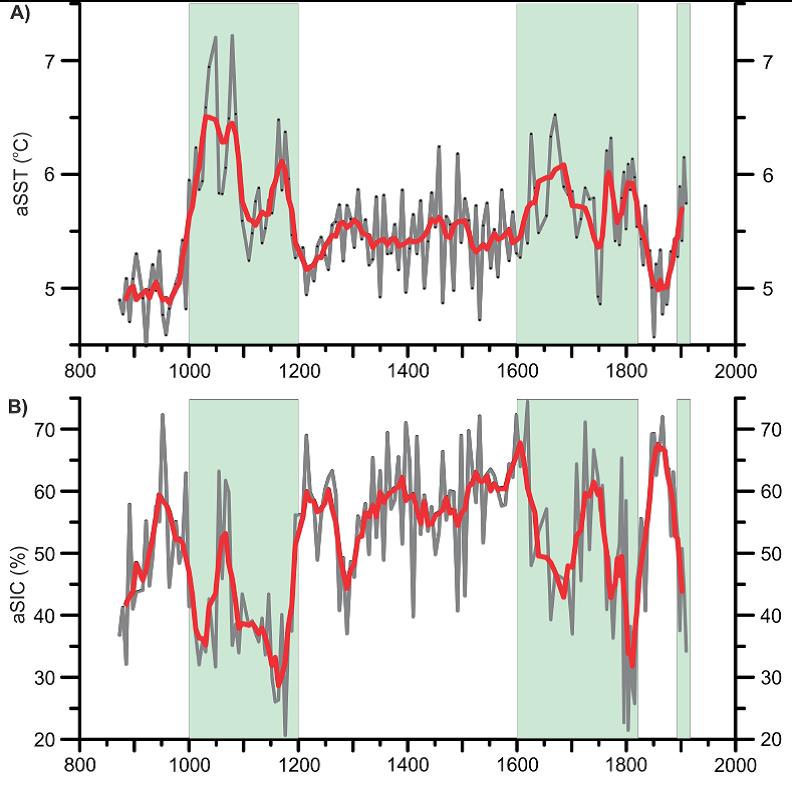Am 26. März 2017 zeichnete Der Tagesspiegel ein düsteres Bild für das arktische Meereis:
Globaler Klimawandel: Der Arktis geht das Eis aus
Forscher warnen: Noch nie war am Ende des Winters die zugefrorene Fläche so klein. Es ist der dritte Rekord-Tiefststand in FolgeEin ungewöhnlich milder arktischer Winter hat der Nordpolarregion einen neuen unerfreulichen Rekord beschert. Noch nie gab es am Ende dieser Jahreszeit so wenig Eis auf dem Arktischen Ozean. Für die Eisbedeckung in dem nun einsetzenden Sommerzyklus sind dies schlechte Voraussetzungen. Das National Snow and Ice Data Centre (NSIDC) der Universität von Colorado in Boulder gab nun die maximale Eisfläche auf dem nördlichen Polarmeer im Winter 2016/2017 an. Die Meereisfläche wuchs in der kalten Jahreszeit nur auf 14,42 Millionen Quadratkilometer an. Gemessen wurde dies am 7. März. „Das ist der niedrigste Stand in den 38 Jahren mit Satellitenmessungen“, teilte das NSIDC mit.
Ersteinmal: Es ist richtig, dass das arktische Meereis derzeit ziemlich geschrumpft ist. Climate4You zeigt die Entwicklung auf Basis des NSIDC (Stand Februar 2017):

Abbildung 1: Entwicklung der arktischen (blau) und antarktischen (rot) Meereisbedeckung währen der letzten 35 Jahre. Quelle: Climate4You auf Basis von NSIDC.
Die Formulierung „noch nie“ ist natürlich grob irreführend, wenn man bedenkt, dass die Satellitendaten gerade einmal ein paar Jahrzehnte zurückreichen. Ein sinnvoller Vergleich wäre mit der letzten großen Wärmephase, der Mittelalterlichen Wärmeperiode vor 1000 Jahren. Hier eine Rekonstruktion der Meereisentwicklung vor Grönland von Miettinen et al. 2016:

Abbildung 2: Entwicklung der Temperatur (oben) und Meereisbedeckung (unten) im Bereich von Grönland. Graphik: Miettinen et al. 2016.
Gut zu erkennen ist der starke Rückgang des arktischen Meereises in der Zeit 1000-1200 n.Chr. (untere Kurve in Abb. 2). Dieser wichtige historische Kontext wird in den aktuellen Presseartikeln zum arktischen Meereis komplett ausgeblendet. Das Verschweigen einer unbequemen Vergangenheit ist jedoch keine nachhaltige Erklärungslösung. Umso erfreulicher ist ein Artikel auf Spiegel Online vom 14. März 2017 zu einer neuen Arbeit, die den aktuellen Meereisschwund zu einem großen Teil der natürlichen Variabilität zuschreibt:
Eisschwund in der Arktis: Schuld ist nicht nur der Mensch
Das Eis der Arktis wird immer kleiner. Die Verantwortung dafür trägt die Menschheit – aber nicht allein, wie eine neue Studie zeigt.[…] Etwas komplizierter wird die Sache allerdings dadurch, dass der Mensch ganz offenbar nicht allein verantwortlich ist für das Verschwinden des Eises. „Seriöse Leute haben schon lange gesagt, dass natürliche Variabilität beim Meereisrückgang eine Rolle spielt“, sagt etwa Rüdiger Gerdes vom Alfred-Wegener-Institut in Bremerhaven. Und auch Claire Parkinson vom Goddard Space Flight Center der Nasa in Greenbelt (US-Bundesstaat Maryland) bestätigt: „Polarforschern ist schon lange klar, dass Veränderungen beim Meereis verschiedene Ursachen haben.“ […] Mit Computermodellierungen berechnete [ein Forscherteam um Qinghua Ding von der University of California Santa Barbara] dafür zunächst, welchen Anteil die atmosphärische Zirkulation im September am Verlust des Meereises insgesamt hatte. Dabei kamen sie auf einen stattlichen Beitrag von bis zu 60 Prozent. Nun ist es allerdings so, dass die Emissionen der Menschen – und die daraus resultierenden Temperaturänderungen in der Atmosphäre – die großräumigen Windsysteme der Erde auch beeinflussen. Also nahmen Ding und seine Kollegen diesen menschengemachten Beitrag aus ihrer Rechnung wieder heraus. Übrig blieb ein natürlicher Anteil von 30 bis 50 Prozent am Verschwinden des sommerlichen Meereises.
Ganzen Artikel auf Spiegel Online lesen.
Hochspannend: Bis zur Hälfte der sommerlichen Meereisschmelze in der Arktis geht auf das Konto der natürlichen Variabilität. Der Tagesspiegel hätte dies in seinem Artikel gerne erwähnen können. Lieber schwieg man, denn das Volk hätte es ja missverstehen können. Für alle mutigen Leser daher hier der Originalabstract von Ding et al. aus Nature Climate Change. Das Paper erschien dort am 13. März 2017:
Influence of high-latitude atmospheric circulation changes on summertime Arctic sea ice
The Arctic has seen rapid sea-ice decline in the past three decades, whilst warming at about twice the global average rate. Yet the relationship between Arctic warming and sea-ice loss is not well understood. Here, we present evidence that trends in summertime atmospheric circulation may have contributed as much as 60% to the September sea-ice extent decline since 1979. A tendency towards a stronger anticyclonic circulation over Greenland and the Arctic Ocean with a barotropic structure in the troposphere increased the downwelling longwave radiation above the ice by warming and moistening the lower troposphere. Model experiments, with reanalysis data constraining atmospheric circulation, replicate the observed thermodynamic response and indicate that the near-surface changes are dominated by circulation changes rather than feedbacks from the changing sea-ice cover. Internal variability dominates the Arctic summer circulation trend and may be responsible for about 30–50% of the overall decline in September sea ice since 1979.
Siehe auch Bericht in der Welt vom 14. März 2017:
Klimawandel: Auch natürliche Gründe für Eis-Schwund der Arktis
[…] Lange Zeit gingen [Experten] davon aus, dass das Handeln des Menschen, der übermäßige Ausstoß von Treibhausgasen in die Atmosphäre, die Erwärmung am Nordpol vorantreibt. Dass der Mensch also schuld ist, wenn sich die biologischen Netzwerke im Eis des Nordens auflösen. Eine neue Studie aber sieht das anders. Der drastische Rückgang des sommerlichen Meereises in der Arktis geht demnach zu einem großen Teil auf natürliche Schwankungen zurück. Etwa 40 Prozent des Schwunds beruhten auf vom Treibhauseffekt unabhängigen Luftströmungen, schätzen US-Forscher um Qinghua Ding von der University of California in Santa Barbara im Fachblatt „Nature Climate Change“.Ganzen Artikel in der Welt lesen.
Hier die dazugehörige Pressemitteilung der University of Washington vom 13. März 2017:
Rapid decline of Arctic sea ice a combination of climate change and natural variability
Arctic sea ice in recent decades has declined even faster than predicted by most models of climate change. Many scientists have suspected that the trend now underway is a combination of global warming and natural climate variability.
A new study finds that a substantial chunk of summer sea ice loss in recent decades was due to natural variability in the atmosphere over the Arctic Ocean. The study, from the University of Washington, the University of California Santa Barbara and federal scientists, is published March 13 in Nature Climate Change. “Anthropogenic forcing is still dominant — it’s still the key player,” said first author Qinghua Ding, a climate scientist at the University of California Santa Barbara who holds an affiliate position at the UW, where he began the work as a research scientist in the UW’s Applied Physics Laboratory. “But we found that natural variability has helped to accelerate this melting, especially over the past 20 years.” The paper builds on previous work by Ding and other UW scientists that found changes in the tropical Pacific Ocean have in recent decades created a “hot spot” over Greenland and the Canadian Arctic that has boosted warming in that region.
The hot spot is a large region of higher pressure where air is squeezed together so it becomes warmer and can hold more moisture, both of which bring more heat to the sea ice below. The new paper focuses specifically on what this atmospheric circulation means for Arctic sea ice in September, when the ocean reaches its maximum area of open water. “The idea that natural or internal variability has contributed substantially to the Arctic sea ice loss is not entirely new,” said second author Axel Schweiger, a University of Washington polar scientist who tracks Arctic sea ice. “This study provides the mechanism, and uses a new approach to illuminate the processes that are responsible for these changes.”
Ding designed a new sea ice model experiment that combines forcing due to climate change with observed weather in recent decades. The model shows that a shift in wind patterns is responsible for about 60 percent of sea ice loss in the Arctic Ocean since 1979. Some of this shift is related to climate change, but the study finds that 30-50 percent of the observed sea ice loss since 1979 is due to natural variations in this large-scale atmospheric pattern. “What we’ve found is that a good fraction of the decrease in September sea ice melt in the past several decades is most likely natural variability. That’s not really a surprise,” said co-author David Battisti, a UW professor of atmospheric sciences. “The method is really innovative, and it nails down how much of the observed sea ice trend we’ve seen in recent decades in the Arctic is due to natural variability and how much is due to greenhouse gases.”
The long-term natural variability is ultimately thought to be driven by the tropical Pacific Ocean. Conditions in the tropical Pacific set off ripple effects, and atmospheric waves snake around the globe to create areas of higher and lower air pressure. Teasing apart the natural and human-caused parts of sea ice decline will help to predict future sea ice conditions in Arctic summer. Forecasting sea ice conditions is relevant for shipping, climate science, Arctic biology and even tourism. It also helps to understand why sea ice declines may be faster in some decades than others. “In the long term, say 50 to 100 years, the natural internal variability will be overwhelmed by increasing greenhouse gases,” Ding said. “But to predict what will happen in the next few decades, we need to understand both parts.”
What will happen next is unknown. The tropical Pacific Ocean could stay in its current phase or it could enter an opposite phase, causing a low-pressure center to develop over Arctic seas that would temporarily slow the long-term loss of sea ice due to increased greenhouse gases. “We are a long way from having skill in predicting natural variability on decadal time scales,” Ding said. The research was funded by NOAA, the National Science Foundation, NASA and the Tamaki Foundation. Other co-authors are Stephen Po-Chedley, Eduardo Blanchard-Wrigglesworth and Ryan Eastman in the UW’s Department of Atmospheric Sciences; Eric Steig in the UW’s Department of Earth and Space Sciences; and Michelle L’Heureux, Kristin Harnos and Qin Zhang at the National Oceanographic and Atmospheric Administration’s Climate Prediction Center.